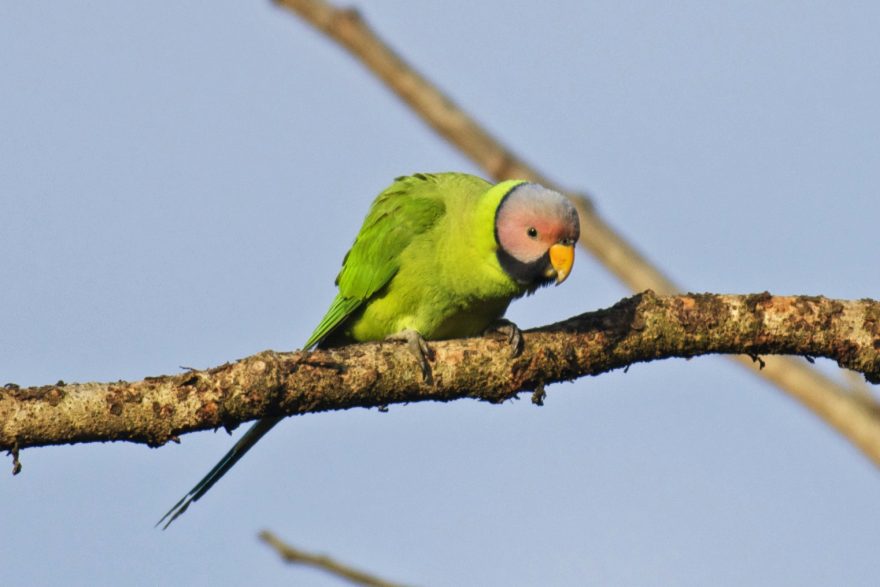The Blossom-headed parakeet is an Asiatic parrot species found throughout India and South-East Asia. The are slightly smaller than the similar Plum-headed parakeet, and are far less frequently kept in captivity. The species is suitable as both a companion bird or an aviary bird. Only male Blossom-headed parakeets possess the vividly colorful head, which is acquired at around 18 months of age. The female has a blueish grey head and darker, less vibrant green plumage.

Housing & Compatibility
Blossom-headed parakeets are placid birds that can share an aviary with other placid parrots (such as Neophemas), finches, and doves. The female may become aggressive during the breeding season (which occurs in the spring), at which point single-pair aviaries may be necessary.
Blossom-headed parakeets should be provided with an adequate amount of flying space to ensure they receive sufficient exercise. Birds that do not have room to fly may suffer from stress or obesity. Three meters of uninterrupted flying space is recommended.
Branches from non-toxic trees should be provided as natural perches. The birds will also enjoy chewing on bark, leaves and seeds for entertainment and beak exercise.
Blossom-headed parakeets are closely related to Plum-headed parakeets and Slaty-headed parakeets, and are capable of interbreeding. To avoid producing hybrid birds that damage the limited captive gene pool of each distinct species, these birds should not be housed together. Hybrids between male Rose-ringed parakeets (Indian Ringnecks) and female blossom-headed parakeets have also been reported.
Diet & Feeding
Seed forms the basis of the Blossom-headed parakeet’s diet. A quality mix designed for small parrots or Lovebirds will be acceptable. Blossom-headed Parakeets also require a wide variety of fruit and vegetables to ensure good health. They prefer sweet juicy fruits such as apple and pear, but it’s important to also provide more-nutritious green foods such as broccoli, kale and bok choi. Corn on the cob is especially loved, as are peppers (chillis) and berries.
Pellets can be used as a more nutritious alternative to seed, but many birds are unwilling to consume them.
Blossom-headed parakeets like to hold their food in one foot while perching with the other. Cutting fruits and vegetables into cubes of roughly one square inch will allow them to practice this natural behavior.
Breeding
Blossom-headed parakeets have a reputation for being difficult to breed. Even under ideal conditions, they will only produce one clutch of 3-6 eggs per year.
Breeding usually commences in spring as the weather begins to warm up. The male will court and feed the hen, who will begin inspecting available nesting boxes. Several different nesting boxes should be provided, as they are known to reject some nesting boxes for seemingly arbitrary reasons.
Incubation is performed exclusively by the hen and lasts for roughly three weeks. Young birds will fledge at 6-7 weeks of age and become fully independent from their parents a month later. Young birds can usually be housed with their parents, but they must be separated immediately if aggressive behavior is observed.
Nest box
Blossom-headed parakeets will accept a wide range of different nesting boxes or logs. A commercial nesting box designed for medium-sized parrots – either rectangular or Z-shaped – is ideal. An inch-thick layer of shaved pine or sawdust should be placed in the bottom of the nest.
Sexing
Only the male bird possess the namesake “blossom head,” making adult birds very easy to visually sex. Juvenile birds of different sexes remain identical for twelve months or more until the males begin to develop different-coloured head feathers. DNA sexing is the only way to accurately determine gender before this point.
Color Mutations
Mutations are extremely rare and few, if any, have been established
As Pets
Blossom-headed parakeets are not frequently kept as companion birds, but they can become excellent pets. They are competent talkers and have a reputation for being friendly and confiding. Like most Asiatic parrots, blossom-headed parakeets often go through a period of “bluffing” during the early years of their life. Bluffing is somewhat like human puberty in that it causes erratic, sometimes aggressive behaviour due to hormonal changes. With patience and commitment, this developmental stage will inevitably pass.
Health
A strict worm control regime and regular preventative treatment for bacterial and fungal infections is critical to ensure the long-term health of any bird.
A properly cared for blossom-headed parakeet will live for 15-25 years.